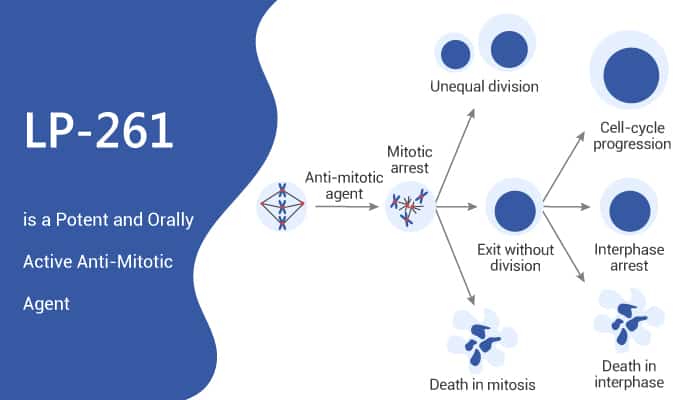In this article, we will introduce a potent anti-mitotic agent, LP-261.

LP-261 shows inhibition of in vitro tubulin polymerization with an EC50 of 3.2 μM. Firstly, in vitro, LP-261 exhibits potent G2/M block activity in multiple cell lines and exhibits a range of activity from 0.01 μM to 0.38 μM. Besides, the IC50 values for MCF-7, H522, Jurkat, SW-620, BXPC-3, and PC-3 values are 0.01 μM, 0.01 μM, 0.02 μM, 0.05 μM, 0.05 μM and 0.07 μM, respectively.
Additionally, LP-261 exhibits low micromolar potency in the tubulin polymerization assay. The EC50 value of LP-261 is 5.0 μM. Besides, this anti-mitotic agent also has the ability to compete with colchicine for binding to tubulin in a [3H]colchicine competition binding assay. And the EC50 (3.2 μM) for LP-261 to inhibit the binding with a potency similar to that of colchicine itself. Additionally, at a concentration of 30 μM, LP-261 exhibits a 79% inhibition at a concentration of 30 μM.
LP-261 also exhibits potent anti-cancer activity in vivo.
LP-261 exhibits good pharmacokinetic activity. After an oral gavage of LP-261, LP-261 displays rapid absorption by the oral route (Tmax=2.0 h). As a result, the terminal half-life of 1.4 h (0.2 h indicated a moderate rate of elimination in rats, and the volume of distribution (Vss) is 1.25.
In a human tumor xenograft model (injected with NCI-H522 human non-small-cell) in NCr-nu mice. LP-261 has potent anti-tumor efficacy at high dosage and exhibits no significant changes in body weights. At a dosage of 50 mg/kg, LP-261 results in an approximately tumor volume of 130 mm3 versus 3769 mm3 in the vehicle-treated group. This represents a 96% reduction in mean tumor volume. Meanwhile, LP-261 at 15 mg/kg leads to a 41% inhibition after 28 days in this mouse model.
In conclusion, LP-261, as an anti-mitotic agent, exhibits potent anti-cancer activities. It inhibits the growth of a human non-small-cell lung tumor (NCI-H522) in vivo and can be used for cancer research.
Reference:
[1]. Rupa S Shetty, et al. J Med Chem. 2011 Jan 13;54(1):179-200